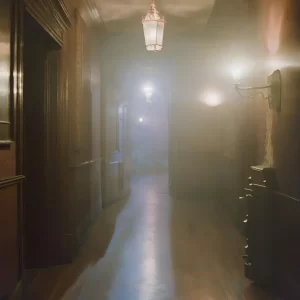Haunted Plant Hall

The city of Tampa, Florida has a lot to offer. From the stunning white sand beaches of the Gulf Coast to the thrilling theme parks of Busch Gardens, there’s always something to do in Tampa. And with so much going on, it’s a wonder the students at the University of Tampa get any work done. Located in the heart of downtown, all 60 buildings and 110 acres of the university are deeply integrated into the inner workings of the city, and the school’s unique minaret towers have even become an iconic, instantly recognizable feature of the Tampa skyline.
But when the students are finally able to tear themselves away from everything the city has to offer, a distraction of an entirely different sort may still prevent them from finishing up their work. The university’s historic Plant Hall is rumored to be haunted by a terrifying spirit known as the “Brown Man,” believed by many to be the ghost of Henry Plant himself. To this day, University of Tampa students remain in agreement that the only thing more terrifying than a mountain of overdue assignments is a run-in with the ghost of Plant Hall, although admittedly he does make for a pretty good excuse.
More: Top 10 Haunted Places in Tampa
History and Background
Plant Hall is a stunning feat of Moorish Revival architecture quite unlike anything else in the city, characterized by its Victorian gingerbread trim, red brick exterior, and silver domes and minaret turrets. Today, Plant Hall houses classrooms, faculty departments, and administrative offices, but it hasn’t always. The hall was originally built as the Tampa Bay Hotel by wealthy businessman and railroad mogul Henry Plant, who modeled the hotel after European architecture to appeal to his well-traveled Victorian guests. Rivaling Plant’s love for European architecture was his love for European art, and in the years before the hotel opened for business, Plant amassed a lavish collection of artwork and furniture to decorate the Tampa Bay Hotel. European artifacts reportedly arrived by the “trainload,” and despite the resort’s size, Plant’s stash of objects overflowed, forcing him to sell a large portion of them at auctions.
Construction on the massive structure lasted from 1888 until 1891, and cost Plant around $3 million to complete. Along with the Tampa Bay Hotel, Plant constructed seven other luxury resorts across the southern United States to act as pit stops along his railway line, the Plant System. Out of the eight, the Tampa Bay was anonymously the most beautiful, attracting tens of thousands of guests to Florida’s gulf coast every year.
Along with its unique architectural style, the hotel possesses quite a few other novel features. The building itself covers six acres of land and stretches a quarter-mile in length. The hotel also boasts the first-ever elevator installed in the state of Florida. In the 1890s, this was quite a feat! Even more impressive, the mechanism still operates to this day, making it one of the oldest continually operating elevators in the United States.
The elevator wasn’t the hotel’s only first for Florida, as the 511 suites became the first in the state to feature telephones and electric lights. Plant also installed a bowling alley, golf course, racetrack, casino, and an indoor pool throughout the hotel’s 21 buildings. All of that luxury came with a price, however, as a night at the Tampa Bay could cost guests up to $15 a night, while the majority of Tampa hotels charged somewhere between $1.25 and $2.00. In the 1890s, luxury hotels in the American South were a fairly novel concept, and Henry Plant was more than happy to cash in on the fast-growing market.
Though no longer in operation, the grand Tampa Bay Hotel had a good run. The hotel operated from 1891 to 1930 and accommodated an impressive array of guests, including U.S. President Teddy Roosevelt, the Prince of Wales, U.K Prime Minister Winston Churchill, and legendary baseball player Babe Ruth, who hit his longest recorded home run during his stay. But as the onset of the Great Depression began to negatively impact the tourism industry, the lavish legacy of the Tampa Bay Hotel drew to an end, leading Plant to shut down operations completely by 1930.
In 1933, the Tampa Bay Junior College held its first classes in the former suites of the resort, and the space provided by the former hotel allowed the college to expand into the University of Tampa. Alongside the newly minted university, the city of Tampa established the Tampa Municipal Museum to preserve the hotel’s historic beauty. By the 1970s, the museum was renamed the Henry B. Plant Museum, and currently houses a plethora of unique artifacts from Plant’s original forays into Europe, including rococo style bronze statues, antique clocks, paintings and tapestries, and an ornate vase gifted to Plant by the Emperor of Japan. The former hotel has since landed a spot on the National Register of Historic Places, and remains one of the city of Tampa’s most unique and iconic structures; and according to some, its most haunted.
Related: 100 years of Tampa history in photographs
Haunted Happenings
If you take a walk through the University of Tampa campus and ask any student directions to Plant Hall, it’s likely to come with a warning—enter if you dare. The historic hall is rumored to house a number of spirits from its days as a luxury resort, most infamously the spirit of the hotel’s owner Henry Plant. Students of the university describe Plant’s ghost as a tall, shadowy figure with long white hair, a white mustache, and glowing red eyes. His ghost has typically been spotted wearing a brown suit, leading many to refer to him simply as “the brown man.”
One student details a particularly frightening encounter with the so-called brown man of Plant Hall. According to her report, she was running late for an early class located on one of the upper floors of the hall. She rushed up the stairs and had just turned the corner of a long deserted hallway when something stopped her in her tracks: the figure of a tall man in an old-fashioned brown suit stood at the end of the hallway. He wore a wide-brimmed hat covering most of his face, but the girl could make out a few strands of stray white hairs around his face. The hairs seemed almost to float around his head as if he were underwater. In fact, on second glance, the man’s whole body appeared to hover a few inches above the ground!
His presence sent an inexplicable chill down her spine. When the student opened her mouth to address the strange figure, he lifted the brim of his hat to reveal a pair of glowing red eyes. Then he vanished into nothing. Utterly terrified by what she had seen, the student burst into her classroom and breathlessly recounted the entire story to her bewildered professor. When she had finished, her professor looked her up and down and asked if that was why she had shown up late to class. Apparently, Henry Plant serves as a hall pass as well as an excuse for overdue homework at the University of Tampa.
The next story circulating about the haunted Plant Hall comes to us from another former student. According to his report, the student was busy studying in an unoccupied classroom in Plant Hall when he heard the door to the classroom creak open, and footsteps enter the room. The footsteps then came to a stop and took a seat at the desk right behind him. But when the student turned around, no one was there! Perhaps the ghost of Henry Plant needed to borrow some notes.
Other reports of Henry Plant claim that after materializing, the ghost rushes into the face of anyone who dares to acknowledge his presence, then disappears. Most long-term faculty and staff at Plant Hall advise newcomers that it’s best to just avoid eye contact; if you leave him alone, he’ll do the same for you, they say.
Some paranormal experts believe Henry Plant’s spirit remains trapped inside the hall bearing his name due because of his strong attachment to his vast collection of antiques. Since so many of these artifacts had to be sold at auctions, perhaps Plant feels the need to protect what remains of his possessions. Others maintain that Plant sticks around merely to strike fear into the hearts of unmotivated students, or to scare away illegal trespassers on his property. Whatever the case may be, the University of Tampa’s own Plant Hall is undeniably one of the most haunted destinations in the city, and not for the faint of heart.
Sources:
https://www.wfla.com/news/local-news/florida-ghost-stories-8-most-haunted-locations-in-tampa-bay/
https://weeklyspartan.wordpress.com/2015/02/12/the-haunting-of-plant-hall/
https://www.fox13news.com/news/above-plant-halls-iconic-minarets-and-moons
https://www.ut.edu/about-ut/history
